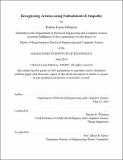| dc.contributor.advisor | Patrick H. Winston. | en_US |
| dc.contributor.author | McIntyre, Robert Louis | en_US |
| dc.contributor.other | Massachusetts Institute of Technology. Department of Electrical Engineering and Computer Science. | en_US |
| dc.date.accessioned | 2014-11-24T16:16:19Z | |
| dc.date.available | 2014-11-24T16:16:19Z | |
| dc.date.copyright | 2014 | en_US |
| dc.date.issued | 2014 | en_US |
| dc.identifier.uri | http://hdl.handle.net/1721.1/91697 | |
| dc.description | Thesis: M. Eng., Massachusetts Institute of Technology, Department of Electrical Engineering and Computer Science, 2014. | en_US |
| dc.description | This electronic version was submitted by the student author. The certified thesis is available in the Institute Archives and Special Collections. | en_US |
| dc.description | Cataloged from student-submitted PDF version of thesis. | en_US |
| dc.description | Includes bibliographical references (pages 83-85). | en_US |
| dc.description.abstract | Here I demonstrate the power of using embodied artificial intelligence to attack the action recognition problem, which is the challenge of recognizing actions performed by a creature given limited data about the creature's actions, such as a video recording. I solve this problem in the case of a worm-like creature performing actions such as curling and wiggling. To attack the action recognition problem, I developed a computational model of empathy (EMPATH) which allows me to recognize actions using simple, embodied representations of actions (which require rich sensory data), even when that sensory data is not actually available. The missing sense data is imagined by combining previous experiences gained from unsupervised free play. The worm is a five-segment creature equipped with touch, proprioception, and muscle tension senses. It recognizes actions using only proprioception data. In order to build this empathic, action-recognizing system, I created a program called CORTEX, which is a complete platform for embodied AI research. It provides multiple senses for simulated creatures, including vision, touch, proprioception, muscle tension, and hearing. Each of these senses provides a wealth of parameters that are biologically inspired. CORTEX is able to simulate any number of creatures and senses, and provides facilities for easily modeling and creating new creatures. As a research platform it is more complete than any other system currently available. | en_US |
| dc.description.statementofresponsibility | by Robert Louis McIntyre. | en_US |
| dc.format.extent | 85 pages | en_US |
| dc.language.iso | eng | en_US |
| dc.publisher | Massachusetts Institute of Technology | en_US |
| dc.rights | M.I.T. theses are protected by copyright. They may be viewed from this source for any purpose, but reproduction or distribution in any format is prohibited without written permission. See provided URL for inquiries about permission. | en_US |
| dc.rights.uri | http://dspace.mit.edu/handle/1721.1/7582 | en_US |
| dc.subject | Electrical Engineering and Computer Science. | en_US |
| dc.title | Recognizing actions using embodiment & empathy | en_US |
| dc.title.alternative | Recognizing actions using embodiment and empathy | en_US |
| dc.type | Thesis | en_US |
| dc.description.degree | M. Eng. | en_US |
| dc.contributor.department | Massachusetts Institute of Technology. Department of Electrical Engineering and Computer Science | |
| dc.identifier.oclc | 894249493 | en_US |
